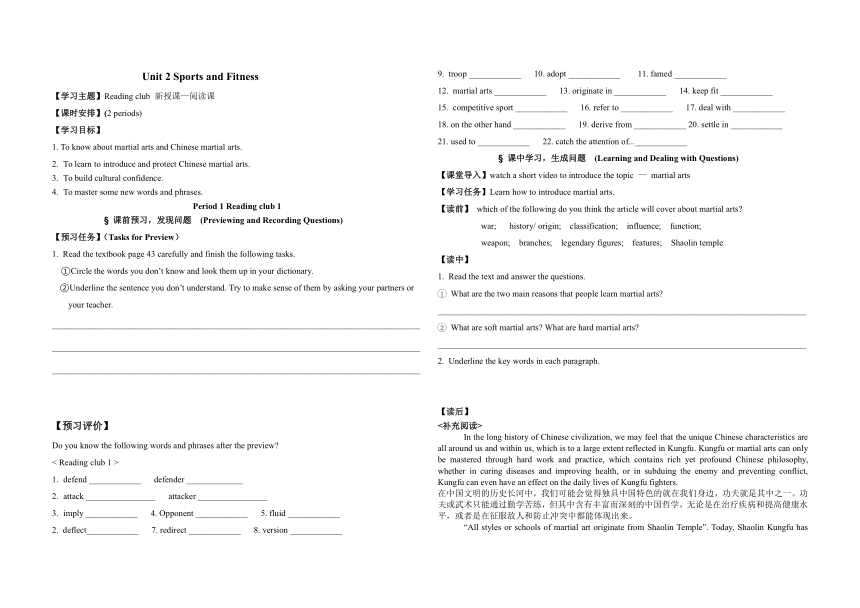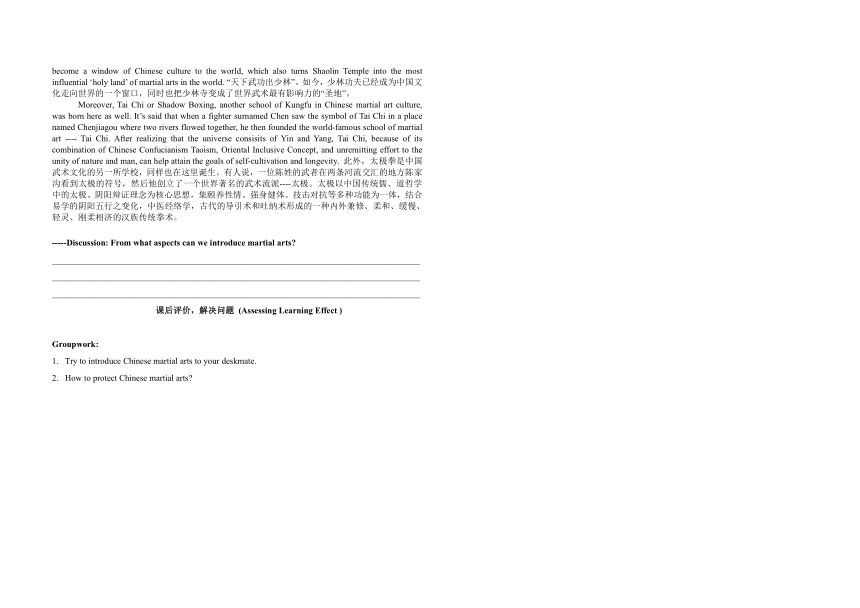北师大版(2019)必修 第一册Unit 2 Sports and Fitness Reading club 学案
文档属性
| 名称 | 北师大版(2019)必修 第一册Unit 2 Sports and Fitness Reading club 学案 |  | |
| 格式 | docx | ||
| 文件大小 | 117.5KB | ||
| 资源类型 | 教案 | ||
| 版本资源 | 北师大版(2019) | ||
| 科目 | 英语 | ||
| 更新时间 | 2023-09-12 19:48:37 | ||
图片预览


文档简介
Unit 2 Sports and Fitness
【学习主题】Reading club 新授课—阅读课
【课时安排】(2 periods)
【学习目标】
1. To know about martial arts and Chinese martial arts.
To learn to introduce and protect Chinese martial arts.
To build cultural confidence.
To master some new words and phrases.
Period 1 Reading club 1
§ 课前预习,发现问题 (Previewing and Recording Questions)
【预习任务】(Tasks for Preview)
Read the textbook page 43 carefully and finish the following tasks.
①Circle the words you don’t know and look them up in your dictionary.
②Underline the sentence you don’t understand. Try to make sense of them by asking your partners or
your teacher.
_______________________________________________________________________________________________________________________________________________________________________________________________________________________________________________________________
【预习评价】
Do you know the following words and phrases after the preview
< Reading club 1 >
defend ____________ defender _____________
attack ________________ attacker ________________
imply ____________ 4. Opponent ____________ 5. fluid ____________
deflect____________ 7. redirect ____________ 8. version ____________
troop ____________ 10. adopt ____________ 11. famed ____________
martial arts ____________ 13. originate in ____________ 14. keep fit ____________
competitive sport ____________ 16. refer to ____________ 17. deal with ____________
18. on the other hand ____________ 19. derive from ____________ 20. settle in ____________
21. used to ____________ 22. catch the attention of...____________
§ 课中学习,生成问题 (Learning and Dealing with Questions)
【课堂导入】watch a short video to introduce the topic — martial arts
【学习任务】Learn how to introduce martial arts.
【读前】 which of the following do you think the article will cover about martial arts
war; history/ origin; classification; influence; function;
weapon; branches; legendary figures; features; Shaolin temple
【读中】
Read the text and answer the questions.
What are the two main reasons that people learn martial arts
_____________________________________________________________________________________
What are soft martial arts What are hard martial arts
_____________________________________________________________________________________
Underline the key words in each paragraph.
【读后】
<补充阅读>
In the long history of Chinese civilization, we may feel that the unique Chinese characteristics are all around us and within us, which is to a large extent reflected in Kungfu. Kungfu or martial arts can only be mastered through hard work and practice, which contains rich yet profound Chinese philosophy, whether in curing diseases and improving health, or in subduing the enemy and preventing conflict, Kungfu can even have an effect on the daily lives of Kungfu fighters.
在中国文明的历史长河中,我们可能会觉得独具中国特色的就在我们身边,功夫就是其中之一。功夫或武术只能通过勤学苦练,但其中含有丰富而深刻的中国哲学,无论是在治疗疾病和提高健康水平,或者是在征服敌人和防止冲突中都能体现出来。
“All styles or schools of martial art originate from Shaolin Temple”. Today, Shaolin Kungfu has become a window of Chinese culture to the world, which also turns Shaolin Temple into the most influential ‘holy land’ of martial arts in the world. “天下武功出少林”。如今,少林功夫已经成为中国文化走向世界的一个窗口,同时也把少林寺变成了世界武术最有影响力的“圣地”。
Moreover, Tai Chi or Shadow Boxing, another school of Kungfu in Chinese martial art culture, was born here as well. It’s said that when a fighter surnamed Chen saw the symbol of Tai Chi in a place named Chenjiagou where two rivers flowed together, he then founded the world-famous school of martial art ---- Tai Chi. After realizing that the universe consisits of Yin and Yang, Tai Chi, because of its combination of Chinese Confucianism Taoism, Oriental Inclusive Concept, and unremitting effort to the unity of nature and man, can help attain the goals of self-cultivation and longevity. 此外,太极拳是中国武术文化的另一所学校,同样也在这里诞生。有人说,一位陈姓的武者在两条河流交汇的地方陈家沟看到太极的符号,然后他创立了一个世界著名的武术流派----太极。太极以中国传统儒、道哲学中的太极、阴阳辩证理念为核心思想,集颐养性情、强身健体、技击对抗等多种功能为一体,结合易学的阴阳五行之变化,中医经络学,古代的导引术和吐纳术形成的一种内外兼修、柔和、缓慢、轻灵、刚柔相济的汉族传统拳术。
-----Discussion: From what aspects can we introduce martial arts
_______________________________________________________________________________________________________________________________________________________________________________________________________________________________________________________________
课后评价,解决问题 (Assessing Learning Effect )
Groupwork:
Try to introduce Chinese martial arts to your deskmate.
How to protect Chinese martial arts
Period 1 Reading club 2
§ 课前预习,发现问题 (Previewing and Recording Questions)
【预习任务】(Tasks for Preview)
Read the textbook page 44-45 carefully and finish the following tasks.
①Circle the words you don’t know and look them up in your dictionary.
②Underline the sentence you don’t understand. Try to make sense of them by asking your partners or
your teacher.
_______________________________________________________________________________________________________________________________________________________________________________________________________________________________________________________________
Look at Page 44 and try to make a class schedule in English for your class
【预习评价】
Do you know the following words and phrases after the preview
< Reading club 2 >
Yoga ____________ 2. Spin ____________ 3. Latin Dance ____________
poster ____________ 5. experienced ____________ 6. flexibility ____________
calorie ____________ 8. joint ____________ 9. train ____________
equipment ____________ 11. impact ____________ 12. lose weight ____________
13. look for ____________ 14. be suitable for ____________ 15. inspire sb. to do.. ____________
§ 课中学习,生成问题 (Learning and Dealing with Questions)
【学习任务一】Learn how to choose proper fitness classes.
Read the information on the posters (Page44-45). Then help the people find proper classes.
【学习任务二】Master some key words and phrases.
flexible
词源:从词根来看,flex-(bend)+ible (can be done)=flexible可被弯曲的。当人的身体“易弯曲”时可译为“柔韧的”随着语言的发展,具体的基本义衍生出了新的抽象意义,flexible可以指人或计划等“可变通的;灵活的”。
释义
① 易弯曲的;柔韧的 able to bend easily without breaking:
② 可变通的;灵活的 able to change to suit any new situation:
派生词 flexibility n柔韧性;灵活性
|练习:根据句意,写出下列句子中flexible的释义。
---The inventors said the material becomes flexible when wet, so they're exploring ways to use it in wet environments. (2012 湖南) 1
---Schedules tend to be flexible, with business meetings sometimes starting later than planned. (2014 浙江)
defend vt.&vi.
①~ (sb/yourself/sth) (from/against sb/sth)to protect sb/sth from attack 防御;保护;保卫
All our officers are trained to defend themselves against knife attacks.
Troops have been sent to defend the borders. 已派出部队去守卫边疆。
②~ sb/yourself/sth (from/against sb/sth)to say or write sth in support of sb/sth that has been criticized 辩解;辩白
Politicians are skilled at defending themselves against their critics.
从政者都善于为自己辩解,反驳别人的批评。
How can you defend such behaviour 你怎能为这种行为辩解呢?
IN SPORT 体育运动
③ ( in sports 体育运动 ) to protect your own goal to stop your opponents from scoring 防守
attack
课后评价,解决问题 (Assessing Learning Effect )
Critical Thinking
① When you choose a fitness activity, what do you consider first and least Why
② Which of the activities appeals to you most Why
【学习主题】Reading club 新授课—阅读课
【课时安排】(2 periods)
【学习目标】
1. To know about martial arts and Chinese martial arts.
To learn to introduce and protect Chinese martial arts.
To build cultural confidence.
To master some new words and phrases.
Period 1 Reading club 1
§ 课前预习,发现问题 (Previewing and Recording Questions)
【预习任务】(Tasks for Preview)
Read the textbook page 43 carefully and finish the following tasks.
①Circle the words you don’t know and look them up in your dictionary.
②Underline the sentence you don’t understand. Try to make sense of them by asking your partners or
your teacher.
_______________________________________________________________________________________________________________________________________________________________________________________________________________________________________________________________
【预习评价】
Do you know the following words and phrases after the preview
< Reading club 1 >
defend ____________ defender _____________
attack ________________ attacker ________________
imply ____________ 4. Opponent ____________ 5. fluid ____________
deflect____________ 7. redirect ____________ 8. version ____________
troop ____________ 10. adopt ____________ 11. famed ____________
martial arts ____________ 13. originate in ____________ 14. keep fit ____________
competitive sport ____________ 16. refer to ____________ 17. deal with ____________
18. on the other hand ____________ 19. derive from ____________ 20. settle in ____________
21. used to ____________ 22. catch the attention of...____________
§ 课中学习,生成问题 (Learning and Dealing with Questions)
【课堂导入】watch a short video to introduce the topic — martial arts
【学习任务】Learn how to introduce martial arts.
【读前】 which of the following do you think the article will cover about martial arts
war; history/ origin; classification; influence; function;
weapon; branches; legendary figures; features; Shaolin temple
【读中】
Read the text and answer the questions.
What are the two main reasons that people learn martial arts
_____________________________________________________________________________________
What are soft martial arts What are hard martial arts
_____________________________________________________________________________________
Underline the key words in each paragraph.
【读后】
<补充阅读>
In the long history of Chinese civilization, we may feel that the unique Chinese characteristics are all around us and within us, which is to a large extent reflected in Kungfu. Kungfu or martial arts can only be mastered through hard work and practice, which contains rich yet profound Chinese philosophy, whether in curing diseases and improving health, or in subduing the enemy and preventing conflict, Kungfu can even have an effect on the daily lives of Kungfu fighters.
在中国文明的历史长河中,我们可能会觉得独具中国特色的就在我们身边,功夫就是其中之一。功夫或武术只能通过勤学苦练,但其中含有丰富而深刻的中国哲学,无论是在治疗疾病和提高健康水平,或者是在征服敌人和防止冲突中都能体现出来。
“All styles or schools of martial art originate from Shaolin Temple”. Today, Shaolin Kungfu has become a window of Chinese culture to the world, which also turns Shaolin Temple into the most influential ‘holy land’ of martial arts in the world. “天下武功出少林”。如今,少林功夫已经成为中国文化走向世界的一个窗口,同时也把少林寺变成了世界武术最有影响力的“圣地”。
Moreover, Tai Chi or Shadow Boxing, another school of Kungfu in Chinese martial art culture, was born here as well. It’s said that when a fighter surnamed Chen saw the symbol of Tai Chi in a place named Chenjiagou where two rivers flowed together, he then founded the world-famous school of martial art ---- Tai Chi. After realizing that the universe consisits of Yin and Yang, Tai Chi, because of its combination of Chinese Confucianism Taoism, Oriental Inclusive Concept, and unremitting effort to the unity of nature and man, can help attain the goals of self-cultivation and longevity. 此外,太极拳是中国武术文化的另一所学校,同样也在这里诞生。有人说,一位陈姓的武者在两条河流交汇的地方陈家沟看到太极的符号,然后他创立了一个世界著名的武术流派----太极。太极以中国传统儒、道哲学中的太极、阴阳辩证理念为核心思想,集颐养性情、强身健体、技击对抗等多种功能为一体,结合易学的阴阳五行之变化,中医经络学,古代的导引术和吐纳术形成的一种内外兼修、柔和、缓慢、轻灵、刚柔相济的汉族传统拳术。
-----Discussion: From what aspects can we introduce martial arts
_______________________________________________________________________________________________________________________________________________________________________________________________________________________________________________________________
课后评价,解决问题 (Assessing Learning Effect )
Groupwork:
Try to introduce Chinese martial arts to your deskmate.
How to protect Chinese martial arts
Period 1 Reading club 2
§ 课前预习,发现问题 (Previewing and Recording Questions)
【预习任务】(Tasks for Preview)
Read the textbook page 44-45 carefully and finish the following tasks.
①Circle the words you don’t know and look them up in your dictionary.
②Underline the sentence you don’t understand. Try to make sense of them by asking your partners or
your teacher.
_______________________________________________________________________________________________________________________________________________________________________________________________________________________________________________________________
Look at Page 44 and try to make a class schedule in English for your class
【预习评价】
Do you know the following words and phrases after the preview
< Reading club 2 >
Yoga ____________ 2. Spin ____________ 3. Latin Dance ____________
poster ____________ 5. experienced ____________ 6. flexibility ____________
calorie ____________ 8. joint ____________ 9. train ____________
equipment ____________ 11. impact ____________ 12. lose weight ____________
13. look for ____________ 14. be suitable for ____________ 15. inspire sb. to do.. ____________
§ 课中学习,生成问题 (Learning and Dealing with Questions)
【学习任务一】Learn how to choose proper fitness classes.
Read the information on the posters (Page44-45). Then help the people find proper classes.
【学习任务二】Master some key words and phrases.
flexible
词源:从词根来看,flex-(bend)+ible (can be done)=flexible可被弯曲的。当人的身体“易弯曲”时可译为“柔韧的”随着语言的发展,具体的基本义衍生出了新的抽象意义,flexible可以指人或计划等“可变通的;灵活的”。
释义
① 易弯曲的;柔韧的 able to bend easily without breaking:
② 可变通的;灵活的 able to change to suit any new situation:
派生词 flexibility n柔韧性;灵活性
|练习:根据句意,写出下列句子中flexible的释义。
---The inventors said the material becomes flexible when wet, so they're exploring ways to use it in wet environments. (2012 湖南) 1
---Schedules tend to be flexible, with business meetings sometimes starting later than planned. (2014 浙江)
defend vt.&vi.
①~ (sb/yourself/sth) (from/against sb/sth)to protect sb/sth from attack 防御;保护;保卫
All our officers are trained to defend themselves against knife attacks.
Troops have been sent to defend the borders. 已派出部队去守卫边疆。
②~ sb/yourself/sth (from/against sb/sth)to say or write sth in support of sb/sth that has been criticized 辩解;辩白
Politicians are skilled at defending themselves against their critics.
从政者都善于为自己辩解,反驳别人的批评。
How can you defend such behaviour 你怎能为这种行为辩解呢?
IN SPORT 体育运动
③ ( in sports 体育运动 ) to protect your own goal to stop your opponents from scoring 防守
课后评价,解决问题 (Assessing Learning Effect )
Critical Thinking
① When you choose a fitness activity, what do you consider first and least Why
② Which of the activities appeals to you most Why
同课章节目录
- Unit 1 Life Choices
- Lesson 1 Lifestyles
- Lesson 2 Understanding and Coping with Stress
- Lesson 3 Your Life Is What You Make It
- Unit 2 Sports and Fitness
- Lesson 1 The Underdog
- Lesson 2 Rules of the Game
- Lesson 3 Running and Fitness
- Unit 3 Celebrations
- Lesson 1 Spring Festival
- Lesson 2 Special Occasions
- Lesson 3 Memories of Christmas
